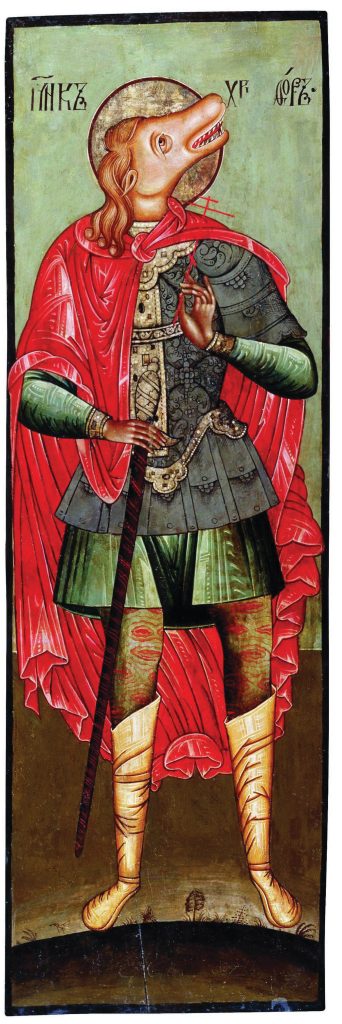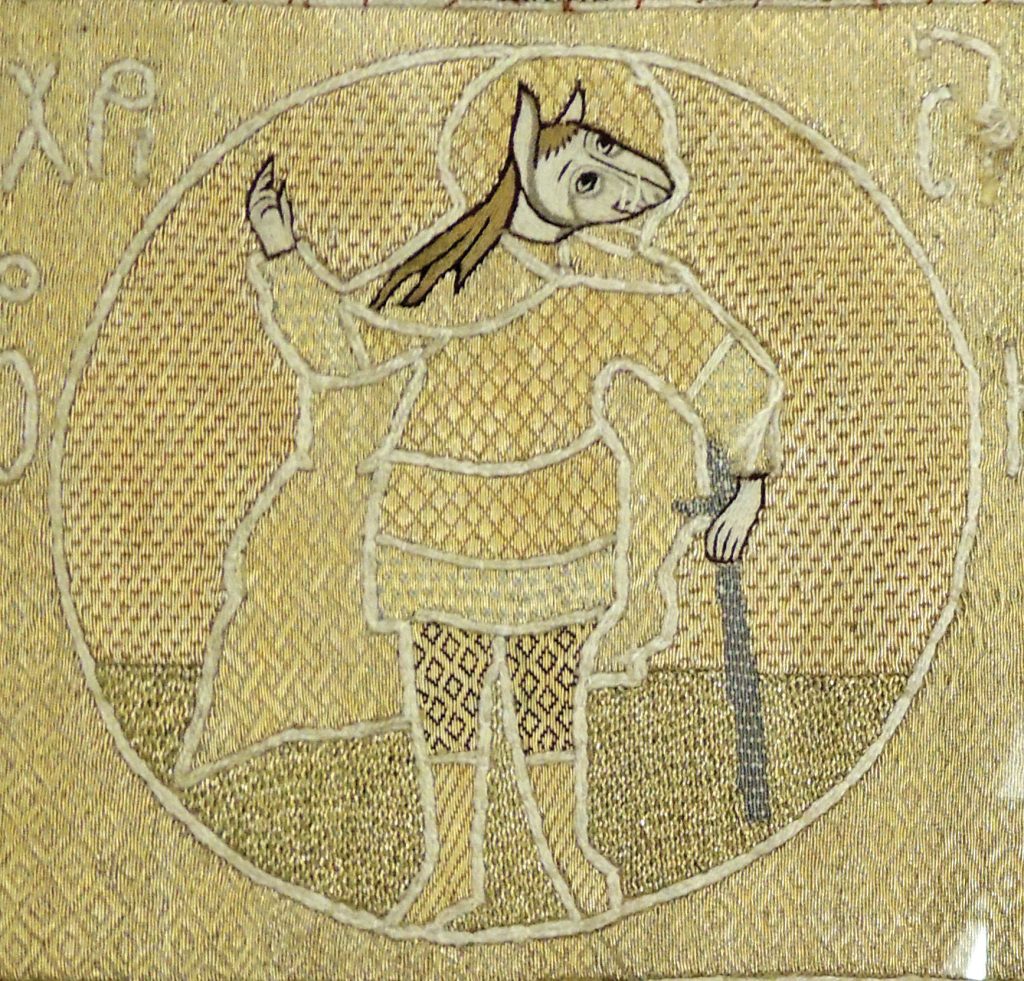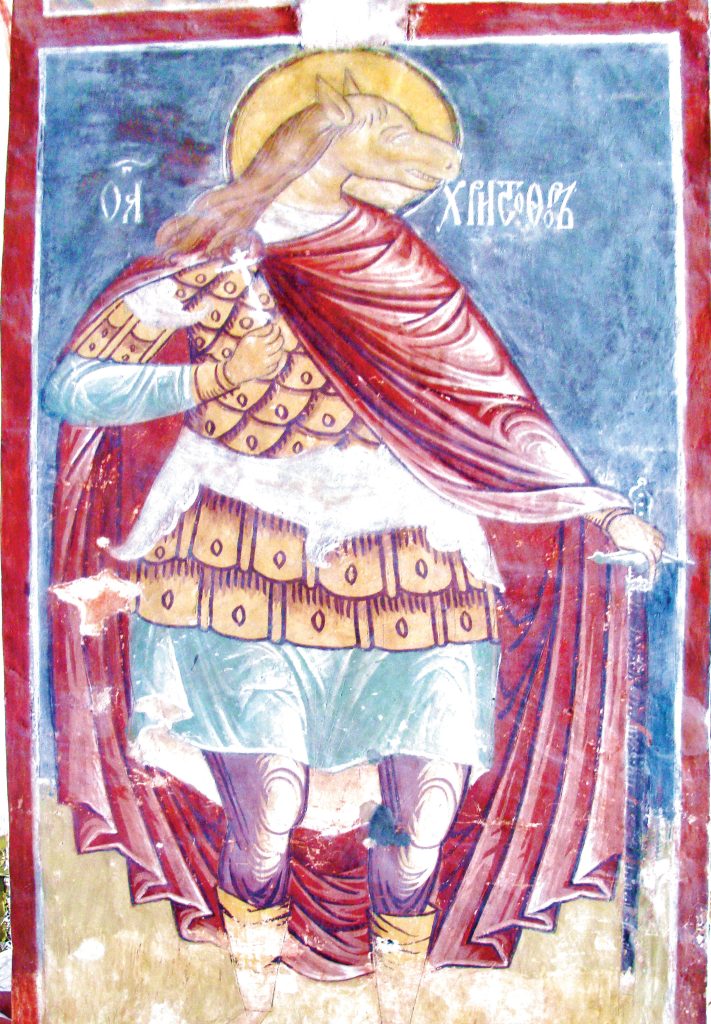
According to French philosopher Emmanuel Levinas, when we look into the face of another person, we see the word of God. The face, Levinas writes, is a conduit for God’s voice, calling us to learn, to take action, to be transformed.
But what if that face is so strange we can’t recognize any commonality? What if the strangeness is so great it interferes with our ability to hear or see divinity? That dilemma is at the heart of the earliest stories about St. Christopher.
Today, St. Christopher’s name usually calls to mind images of a bearded man carrying the Christ child on his shoulders. Although the Second Vatican Council removed Christopher from the liturgical calendar when they revised it in 1969, he is still considered a saint and people continue to wear St. Christopher medals or dangle them from their cars’ rearview mirrors. He’s still considered to be the patron saint of travelers.
But the earliest stories about St. Christopher don’t mention him carrying the child across the water; instead, they focus on a bizarre detail—Christopher’s face, a face so strange it seems impossible that he’s human: Although he possesses a human body, Christopher has a dog’s face.
The first written accounts of Christopher the dog-headed saint date back to the fifth century. One early story, “The Life of Saint Christopher,” comes from an ancient (and probably apocryphal) account of the missionary journeys of the disciples Andrew and Bartholomew. In the disciples’ wanderings through the very edges of the known world, they encounter a dog-headed cannibal who calls himself “Abominable.” The author describes this individual’s nose (like a dog’s snout), teeth (like a boar’s or a lion’s), eyes (like flames), and hair (spilling over his shoulders in a mane); his “whole appearance was awful and terrifying.”
But, the story goes on to say, Abominable senses within himself the spirit of Christ. He asks the disciples to baptize him, and then he takes the name Christopher, because, he says, he carries Christ inside him, even though he has had no words until now to express his awareness. Christopher then becomes the disciples’ guide as they continue on their adventures.
A later account of Christopher’s life describes him as an African named Reprebos who was captured and forced to serve in the Roman Empire’s military. Since medieval Europeans considered Africa to be a “land of cannibals and dog-headed peoples,” the Europeans who first encounter Reprobos view him with fear and loathing.
Even as he is hated and persecuted, however, Reprobos rebels against the Roman military’s cruelty to Christians. He runs away, and when he converts to Christianity, his spear sprouts roots and leaves. As in the other story, he takes the name Christopher because, he says, he bears “Christ within.” In this account, Christopher does much good in the world, bringing Christ within him wherever he goes until he is eventually martyred for his faith.
Finally, we come to a story that describes Christopher literally bearing the Christ child on his shoulders. This account tells of a foreign lord whose wife, though a heathen, prays to Mary for a child. She becomes pregnant with a son.
As an adult, the son—named Offerus—not only has the head of a dog (apparently a common feature in this land), but he is also monstrously large. As he wanders the land, he encounters a Christian hermit who teaches him about Christ.

Now converted, Offerus will still not fast or pray, since these Christian practices seem alien to him. He does, however, agree to use his physical strength and height for God’s sake, by ferrying people across a raging river.
One night, as he carries a small child on his shoulders through the dark water, the load on his shoulders grows so heavy that he staggers beneath its weight. “Who are you?” he gasps to the child on his back.
“I am Christ,” the child replies, “the Creator and Redeemer of the world. From now on your name will be Christopher, for you have born the Christ across the water.” Then the Christ child tells Christopher to plant his staff in the ground, and by morning, it grows into a fruit-bearing tree.
When the people of the land turn to Christianity as a result of this miracle, the king is infuriated and throws Christopher in prison. The king sees only a monster, who must be “abolished from memory and from life.” Christopher’s dog head is cut off, and he becomes a martyr for Christ.
In each of these stories, something about Christopher’s dog face challenges people. It becomes the catalyst for a chain reaction of community transformation. In one of the stories, a woman sees Christopher’s face and runs to tell the others in her village of this “wonder.” She returns with a vast crowd, who also gaze at Christopher’s strange face—and then, somehow, come to Christ. (This story echoes the gospel account of Jesus and the woman at the well: First, a woman sees a stranger and is changed because of her contact with him; then she brings the rest of her community, and they too are changed.)
So, what did all these stories mean to the medieval folk who repeated them and recorded them? What do they have to say to us today?
Despite the varying details, the hagiographers of St. Christopher’s story all agree on one point: Christopher carries Christ within his strange flesh—and he does so even before his conversion. God chooses him, this strangest of strangers, to advance the realm of God on Earth.
Christopher’s stories underline a theme that runs through both the Hebrew and the Christian scriptures: God calls us to be kind to the “strangers” in our midst—the immigrants and refugees, and all the people who look different from us, believe different from us, act different from us.
The Book of Exodus reminds us that circumstances can be reversed, so that we are the ones who stand out as strange (Ex. 23:9). The Hebrew scriptures also insist that the legal rights of residents apply equally to immigrants and foreigners (Ex. 12:49, Lev. 24:22). The Book of Hebrews cautions that if we turn away a stranger, we may reject an angel in disguise (Heb. 13:2). Jesus states it plainly in the gospel: “I was a stranger, and you took me in” (Matt. 25:35). Again and again in scripture, the foreigner, the outcast, the rejected person is the one God chooses to participate in the divine work of healing this world.
When we look into the face of someone different from ourselves, we have two choices. We can turn away in fear, erect protective barriers, even resort to violence. Or we can look into the strangeness and see Christ.

Christopher does not reveal Christ despite his strangeness; he reveals Christ because of his strangeness. After Christopher’s conversion, he does not lose his dog face. In some stories, he does not even adopt Christian customs. And yet the Christ child chooses him.
According to Levinas, when we dare to truly look into a face not like our own, we take the first step toward changing the world. Healthy community grows out of our willingness to encounter differences without being threatened by them. The other remains other, bringing gifts to the community that were lacking.
Ultimately, each of us—and every individual we encounter—is a St. Christopher. Although we sometimes think we want a homogenized world where everyone thinks the same (and agrees with us), Christopher reminds us that we are all strange. We are each unique. When we engage with that strangeness—accept it, welcome it, celebrate it—we too carry the Christ child. We too are Christ-bearers.
Correction: An earlier version of this article stated that St. Christopher was no longer considered a saint after the Second Vatican Council. The Council removed him from the liturgical calendar, but he is still considered a saint.
This article also appears in the July 2024 issue of U.S. Catholic (Vol. 89, No. 7, pages 27-29). Click here to subscribe to the magazine.
Header image: Saint Christopher, Byzantine and Christian Museum
All other images: Wikimedia Commons











Add comment